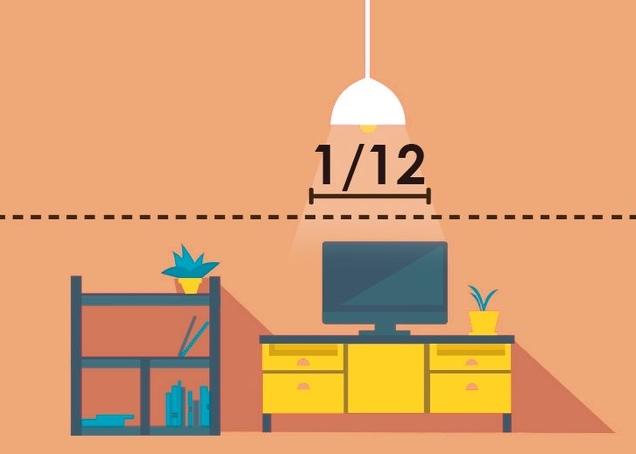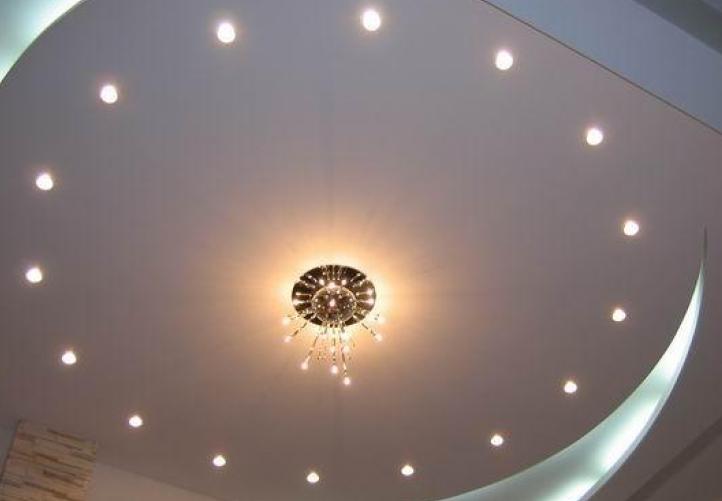How to calculate the necessary amount of lumens per square meter of space
The number of lumens per square meter determines the illuminance level of a room. Different rooms use different values, so you need to understand the standards to ensure good lighting in an apartment or house. For offices, workplaces and garages requirements established norms SNIP and can not deviate from them.

Organization of lighting in the living space
This option is different from the others, a person spends a lot of time in the rooms, so it is necessary to provide high-quality light. From this depends on the comfort of the stay, as well as the load on the eyesight. In the living area it is important to create an atmosphere conducive to relaxation. To do this, lighting of three types is used:
- General. This is realized by installing one or more chandeliers, which usually include several plafonds, evenly distributed in diameter. A light panel, a luminaire with a diffusing plafond, or a large number of recessed light sources may also be used. This is the main option that provides uniform lighting of the room and is used most often.
- Local. It is not always possible to achieve optimal performance at the expense of general lighting. Sometimes it is necessary to allocate a separate area or an area for work, repair, crafts, etc. Table-top, wall-mounted, floor or built-in lamps are used most often. Equipment with the possibility of adjusting the direction of light is well suited.
- Decorative. Serves to decorate the interior, helps to highlight certain areas or elements. Wall or built-in lights are used, which are directed to a specific object.Decorative lighting can serve as a complete element of the interior design.
- Combined. The most convenient solution that combines general and local light and helps to adapt conditions for different purposes. Local light is usually turned on only when necessary, which helps to reduce energy consumption.
If you install track systemThe track system can be used for decorative purposes or to illuminate a particular area of the room. The lights can be easily moved along a conductor and can be directed wherever you like.
Calculation of lumens for the room is usually carried out only for the first two types of lighting. For the decorative variant, it is important to choose the optimal level of illumination and the correct location of fixtures.
Norms of illumination of living rooms according to SNiP
In SNIP prescribed standards for most types of premises. Some of them are recommendations, and some are obligatory to implement, this applies primarily to the workplace and production facilities. You can quickly find out how much light per 1 square meter, if you use the table.
Modern standards are spelled out in lux. It is a unit of illumination, equal to 1 lumendistributed over an area of 1 sq. m. It is a universal indicator that is suitable for all types of rooms.
| Room type | Illumination standard in lux |
| Corridors and vestibules, storage rooms, bathrooms and toilets | From 50 |
| Checkrooms | From 75 |
| Staircases, Saunas and Sauna rooms | From 100 |
| Bedrooms, living rooms and kitchens | From 150 |
| Children rooms and play areas | From 200 |
| Workrooms, libraries, offices with PCs | From 300 |
| Precision workplaces, rooms with drawing boards | From 500 |
| Garages and boxes | From 200 |
Information about light characteristics in lumens should be given on the packaging of the bulb or in the data sheet of the chandelier (if light sources are built-in). But you can roughly estimate values if you know lamp power and its type.

| LED (wattage in W) | Fluorescent (wattage per watt) | Incandescent bulb (Wattage) | Approximate light output (in lumens) |
| 2-3 | 5-7 | 20 | 250 |
| 4-5 | 10-13 | 40 | 400 |
| 8-10 | 15-16 | 60 | 700 |
| 10-12 | 18-20 | 75 | 900 |
| 12-15 | 25-30 | 100 | 1200 |
| 18-20 | 40-50 | 150 | 1800 |
| 25-30 | 60-80 | 200 | 2500 |
One room can also have two lighting zones. For example, a bedroom with a dimmed general light can have a desk with a lamp or a dressing table with bright lighting for makeup application.
Your own calculation of the right amount of light and lighting fixtures
To understand the calculations is not difficult, because all the data can be found in the public domain. If you follow a simple instruction, you can determine the main indicators that will be needed when determining the power and number of lights for a particular room. There are several factors to pay attention to:
- The table determines how many lumens per 1 square meter are required for normal illumination in a particular room. It is easiest to make a general plan of the apartment or house with the recommended lighting for each room, then the probability of errors is reduced. Also take into account lamp type - If they have diffused plafonds or the light flux is directed to the ceiling, you need to increase the values by 20-30%.
- The selected value indicates the norm for a square meter. To calculate the total figure, you need to know the area of the room. It is multiplied by the norm, resulting in a total value for the room. For example, if the illuminance is 200 Lm, and the area is 12 square meters, the final result is 2400 lumens.
- The figures in the tables are given for luminaires that are located at a height of 2.7 meters or lower. But if the light source is higher, you have to use a correction factor, the result that was obtained earlier is multiplied by it. At a height of 2.7 to 3 you need to multiply by 1.2; from 3 to 3.5 - by 1.5; from 3.5 to 4.5 - by 2.The higher the luminaire is positioned, the more its light is diffused.
- It is important to consider the use of the room. If you want a calm, relaxing environment for relaxing or socializing, general ambient lighting is best. Functional lighting is needed to highlight certain areas: work area in the kitchen, desk for working with documents, space for needlework, etc. Accent lighting is needed to highlight certain objects, zoning or decorative lighting.
- The reflection coefficient surfaces have to be taken into consideration. White walls and ceilings reflect 70% of light, light colored walls and ceilings reflect 50%, gray walls reflect 30%, dark walls reflect 10%. The easiest way is to sum up the values of the walls, ceiling and floor, divide the total by 3 and use the averaged correction factor.
When using LED lighting fixtures, you should additionally take into account some parameters that affect lighting:
- Color temperature.: can be warm, neutral or cold. For living spaces, the first 2 types are used.
- Color rendering index (Ra). For normal color perception it should be 80 or higher.
- The flicker index is no more than 10%.
For plants use phytolamps with a certain spectrum.
Video lesson: How to calculate light levels manually.
Possible mistakes when calculating
The most common mistakes made in calculations are the following:
- Correction factors are not taken into account.
- Too bright light is used, creating discomfort.Rooms with too much light can look uncomfortable.
- Fixture placement Illumination is poorly matched and uneven.
- Using average data without examining the information on the lamp packaging.
Calculate the illumination for residential areas is not difficult, because there are norms and you can start from them. It is important to take into account all additional factors and choose equipment with quality and uniform light.



